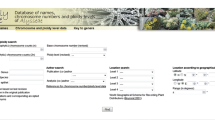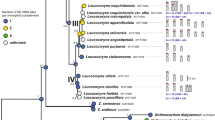Abstract
Nine species of Lecythidaceae subfamily Lecythidoideae in four genera whose chromosome numbers were previously unknown, have 17 as their basic chromosome number:Eschweilera pittieri, three other unidentified species ofEschweilera, Grias cauliflora, Gustavia dubia, G. superba, Lecythis minor, andL. tuyrana. All are diploid exceptGustavia superba, which is tetraploid.Couroupita guianensis, which was previously—and probably incorrectly—reported to have a gametic chromosome number of 18, also hasn = 17. The known chromosome numbers support recognizing at least three of Niedenzu’s subfamilies: Planchonioideae withx = 13, Napoleonaeoideae withx = 16, and Lecythidoideae withx = 17. His fourth subfamily, Foetidioideae, with one genus of five species, has not been counted. Cytological data have been and probably will be useful in indicating to what subfamily problematic genera belong and in showing interesting phytogeographic patterns within the family. On the other hand, cytological data provide no recognizable clues relating the Lecythidaceae to other families.
Similar content being viewed by others
Literature Cited
Atchison, E. 1947. Chromosome numbers in the Myrtaceae. Amer. J. Bot. 34: 159–164.
Banerji, I. 1950. The development of the female gametophyte inCouroupita guianensis Aubl. Curr. Sci. 19: 347.
Bawa, K. S. 1973. Chromosome numbers of tree species of a lowland tropical community. J. Arnold Arbor. 54: 422–434.
Beeks, R. M. 1955. Improvement in the squash technique for plant chromosomes. Aliso 3: 131–133.
Bentham, G. 1865. Myrtaceae: tribus IV, Lecythideae. In: G. Bentham & J. D. Hooker, Genera plantarum 1(2): 720–725.
Bessey, C. E. 1915. The phylogenetic taxonomy of flowering plants. Ann. Missouri Bot. Gard. 2: 109–164.
Bolkhovskikh, Z., V. Grif, T. Matvejeva, &O. Zakharyeva 1969. Chromosome numbers of flowering plants. V. L. Komarov Botanical Institute, Academy of Sciences of the U.S.S.R., Leningrad. [In Russian.]
Candolle, A. P. de 1828. Myrtaceae: tribus IV, Barringtonieae; tribus V, Lecythideae; and Myrtaceae dubiae. In: Prodromus systematis naturalis regni vegetabilis 3: 288–296.
Corner, E. J. H. 1949. The durian theory or the origin of the modern tree. Ann. Bot. (London), n.s., 13: 367–414.
— 1954. The durian theory—III. pachycauly and megaspermy—conclusion. Phytomorphology 4: 263–274.
Cronquist, A. 1968. The evolution and classification of flowering plants. Houghton Mifflin Co., Boston.
Dahlgren, R. 1975. A system of classification of the angiosperms to be used to demonstrate the distribution of characters. Bot. Not. 128: 119–147.
Ehrendorfer, F., F. Krendl, E. Habeler, &W. Sauer 1968. Chromosome numbers and evolution in primitive angiosperms. Taxon 17: 337–353.
Engler, A. 1897. übersicht über die Unterabteilungen, Klassen, Reihen, Unterreihen, und Familien der Embryophyta Siphonogama. pp. 341–357. In: A. Engler (ed.) Die natürlichen Pflanzenfamilien, Nachtrag und Register zu Teil II-IV. Wilhelm Engelmann, Leipzig.
Eyde, R. H. 1975. The bases of angiosperm phylogeny: floral anatomy. Ann. Missouri Bot. Gard. 62: 521–537.
Grant, V. 1971. Plant speciation. Columbia University Press, New York.
Heine, H. 1967. “Ave Caesar, botanici te salutant”: L’épopée Napoléonienne dans la botanique Adansonia, n.s. 7: 115–140.
Hickey, L. J. &J. A. Wolfe 1975. The bases of angiosperm phylogeny: vegetative morphology. Ann. Missouri Bot. Gard. 62: 538–589.
Hutchinson, J. 1973. The families of flowering plants. 3d ed. Clarendon Press, Oxford.
Jussieu, A. L. de. 1789. Genera plantarum secundum ordines naturales disposita, juxta methodum in horto regio Parisiensi exaratam anno 1774. Herissant et Barrois, Paris.
Kartawinata, E. K. 1965. The genusPlanchonia Blume (Lecythidaceae). Bull. Bot. Surv. India 7: 162–187.
Knuth, R. 1939a. Barringtoniaceae.In: A. Engler & L. Diels (eds.) Das Pflanzenreich IV. 219: 1–82.
- 1939b. Lecythidaceae. In: A. Engler & L. Diels (eds.) Das Pflanzenreich IV. 219a: 1–146.
- 1939c. Asteranthaceae. In: A. Engler & L. Diels (eds.) Das Pflanzenreich IV. 219b: 1–3.
Kochummen, K. M. &T. C. Whitmore 1973. Notes on the systematy of Malayan Phanerogams: XVIII-XXII. Gard. Bull. Straits Settlem., ser. 4, 26: 269–287.
Liben, L. 1968.Petersianthus Merrill versusCombretodendron A. Chev. (Lecythidaceae). Bull. Jard. Bot. état 38: 207–208.
— 1971a. Révision du genre africainNapoleonaea P. Beauv. (Lecythidaceae). Bull. Jard. Bot. état 41: 363–382.
— 1971b. Repartition geographique de Combretaceae, Humiriaceae, et Lecythidaceae africaines. Bull. Jard. Bot. état 41: 445–449.
Lindley, J. 1836. A natural system of botany. 2d ed. Longman, London.
— 1846. The vegetable kingdom. Bradbury and Evans, London.
Lowry, J. B. 1976a. Anthocyanins of the Melastomataceae, Myrtaceae, and some allied families. Phytochemistry 15: 513–516.
— 1976b. Floral anthocyanins of some Malesian [sic]Hibiscus species. Phytochemistry 15: 1395–1396.
Mangenot, S. &G. Mangenot 1957. Nombres chromosomiques nouveaux chez diverses Dictoylédones et Monocotylédones d’Afrique occidentale. Bull. Jard. Bot. état 27: 639–654.
— 1958. Deuxième liste de nombres chromosomiques nouveaux chez diverses Dicotylédones et Monocotylédones d’Afrique occidentale. Bull. Jard. Bot. état 28: 315–329.
— 1962. EnquÊte sur les nombres chromosomiques dans une collection d’espèces tropicales. Rev. Cytol. Biol. Vég. 25: 411–447.
Mauritzon, J. 1939. Contributions to the embryology of the orders Rosales and Myrtales. Acta Univ. Lund., n.s., sect. 2, 35(2): 1–120.
Mayr, B. 1969. Ontogenetische Studien an Myrtales-Blüten. Bot. Jahrb. Syst. 89: 210–271.
Mayr, E. 1970. Populations, species, and evolution: an abridgment of animal species and evolution. Harvard University Press, Cambridge [Massachusetts].
Mehra, P. N. 1972. Cytological evolution of hardwoods. Nucleus 15: 64–83.
— &K. S. Bawa 1969. Chromosomal evolution in tropical hardwoods. Evolution 23: 466–481.
Melchior, H. 1964. Myrtiflorae (Myrtales). pp. 345–366. In: H. Melchior (ed.) A. Engler’s Syllabus der Pflanzenfamilien, 12th ed., vol. 2: Angiospermen; übersicht über die Florengebiete der Erde. Gebrüder Borntraeger, Berlin.
Merrill, E. D. 1916. Lecythidaceae: new plants from Samar. Philipp. J. Sci., ser. C, 11: 175–206.
Miers, J. 1874. On the Lecythidaceae. Trans. Linn. Soc. London 30: 157–318.
Mori, S. A. 1974. Taxonomic and anatomic studies inGustavia (Lecythidaceae). Ph.D. Thesis. University of Wisconsin, Madison (Libr. Congr. Card No. Mic. 74-27752). 523 pp. Xerox University Microfilms, Ann Arbor, Mich. (Diss. Abstr. Int., sect. B, 35: 4348).
Muller, J. 1972. Pollen morphological evidence for subdivision and affinities of Lecythida-ceae. Blumea 20: 350–355.
— 1973. Pollen morphology ofBarringtonia calyptrocalyx K. Sch. (Lecythidaceae). Grana 13: 29–44.
Niedenzu, F. 1892. Lecythidaceae. In: A. Engler & K. Prantl (eds.) Die natürlichen Pflanzenfamilien 3(7): 26–41.
Payens, J. P. D. W. 1967. A monograph of the genusBarringtonia (Lecythidaceae). Blumea 15: 157–263.
Pichon, M. 1945. Le genreCombretodendron et les Lécythidacées. Notul. Syst. (Paris) 12: 192–197.
Poiteau, A. 1825. Mémoire sur les Lécythidées. Mém. Mus. Hist. Nat. 13: 141–165.
Prance, G. T. &S. A. Mori 1977. What isLecythis? Taxon 26: 209–222.
Raven, P. H. 1975. The bases of angiosperm phylogeny: cytology. Ann. Missouri Bot. Gard. 62: 724–764.
Raven, P. H. &D. W. Kyhos 1965. New evidence concerning the original basic chromosome number of angiosperms. Evolution 19: 244–248.
Roy, R. P. &R. P. Jha 1965. Cytological studies in Lecythidaceae—II. J. Indian Bot. Soc. 44: 209–217.
Sarkar, A. K., N. Datta, R. Mallick, &U. Chatterjee 1976. Lecythidaceae:Planchonia valida Blume. p. 649. In: A. Löve (ed.) IOPB chromosome number reports LIV. Taxon 25: 631–649.
Sattler, R. 1972. Centrifugal primordial inception in floral development. pp. 170–178. In: Y. S. Murty, B. M. Johri, H. Y. Mohan Ram, & T. M. Varghese (eds.) Advances in Plant Morphology (Prof. V. Puri Commemoration Volume). Sarita Prakashan, Meerut [India].
Shaw, H. K. A. 1973. A dictionary of the flowering plants and ferns: [of] the late J. C. Willis. 8th ed. Cambridge University Press, Cambridge [England].
Smith-White, S. 1959. Cytological evolution in the Australian flora. Cold Spring Harbor Symp. Quant. Biol. 24: 273–289.
Sobti, S. N. &S. D. Singh 1961. A chromosome survey of Indian medicinal plants—part I. Proc. Indian Acad. Sci., sect. B, 54: 138–144.
Stafleu, F. A. (ed.) 1972. International code of botanical nomenclature. Regnum Veg. 82: 1–426.
Stebbins, G. L. 1971. Chromosomal evolution in higher plants. Addison-Wesley Publishing Company, Reading, Massachusetts.
Takhtajan, A. 1969. Flowering plants: origin and dispersal. Smithsonian Institution Press, Washington, D.C.
Thompson, J. M. 1927. Studies in advancing sterility: [III] a study in advancing gigantism with staminal sterility with special reference to the Lecythidaceae. Publ. Hartley Bot. Lab. 4: 5–44.
Thorne, R. F. 1976. A phylogenetic classification of the Angiospermae. Evol. Biol. 9: 35–106.
Walker, J. W. &J. A. Doyle 1975. The bases of angiosperm phylogeny: palynology. Ann. Missouri Bot. Gard. 62: 664–723.
Whitmore, T. C. 1974.Abdulmajidia, a new genus of Lecythidaceae from Malaysia. Kew Bull. 29: 207–211.
Author information
Authors and Affiliations
Rights and permissions
About this article
Cite this article
Kowal, R.R., Mori, S.A. & Kallunki, J.A. Chromosome numbers of Panamanian Lecythidaceae and their use in subfamilial classification. Brittonia 29, 399–410 (1977). https://doi.org/10.2307/2806482
Issue Date:
DOI: https://doi.org/10.2307/2806482




